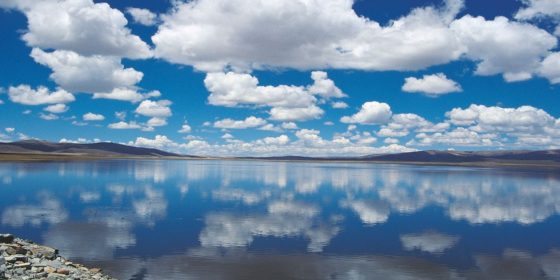Recently, at the bottom of Lake Titicaca, scientists discovered a stone terrace that was once a pavement, a wall one kilometer long, a sculpture and the ruins of an ancient temple (at the same time, the area of \u200b\u200bthe sanctuary turned out to be so huge that it was 200 meters long and 50 wide). The age of the finds found at the bottom of the pit is at least one and a half thousand years, and no one knows anything about them.
Where is Titicaca
Lake Titicaca is located in the north of Antiplano – this is the name of the Andes plateau located at an altitude of 4 thousand meters above sea level. This alpine plain is characterized by a huge number of actively active volcanoes, which at one time formed such a complex terrain that many closed basins arose between them, among them Titicaca, the largest alpine navigable lake in the world and the second largest on the territory of the South American continent.

The western part of this reservoir is located on the territory of Peru, the eastern part is in Bolivia (at the same time, a mountain peak called Cordillera Real, which is located on the northeast coast, is considered one of the highest mountains of the Andes – its height exceeds 6.5 thousand m) .
If you look at the map in order to determine where Lake Titicaca is located, then it can be found at the following geographical coordinates: 15 ° 50′11 ″ S. sh. 69°20′19″ W d.
What does the lake look like
The origin of Titicaca is quite interesting: scientists believe that more than 100 million years ago this reservoir was at the level of the World Ocean and was a bay – this fact is confirmed by the slopes of the mountains, on which geologists found traces of the sea surf, as well as the fossilized remains of marine animals found on the coast .
Geologists say that at an altitude of 3812 m above sea level. m. Lake Titicaca turned out to be not immediately, but gradually, along with the growth of the Andes, mountains, which, by the way, still have not stopped growing (they do this, however, unevenly – in the north the process is much more noticeable than in the south) . The characteristics of this reservoir are quite interesting.
If you look at the map, you can see that the shape of Lake Titicaca resembles a puma (hence its name came from, which is translated from the language of the Quechua tribe quite interestingly – “kaka” means “rock”, “titi” – puma).
The area of the basin is 8372 km. sq., and this body of water is almost an inland sea. The salinity level of the water is not more than 1%, therefore the reservoir is considered freshwater and is the largest in South America in terms of fresh water reserves. The basin is 190 km long and 80 km wide.
The Titicaca Strait, which is 800 meters wide, divides Titicaca into two parts. The depths of the two basins of the reservoir differ significantly from each other, since the bottom of Titicaca is strongly inclined towards the east coast. The average depth of most of the lake is 135 meters, max. – 284 m, and the average depth of the smaller part of the lake is about 10 m, max. – 40 m.
Despite the fact that many believe that Lake Titicaca is endorheic and has no connection with the World Ocean, this is not entirely true: thanks to the small Desaguadero river, which flows into Lake Poopo, which takes about 10% of Titicaca’s water with it, the largest the fresh water body of the continent can still be called a sewage lake. The level of Titicaca is constantly changing: during the rainy season it rises, and in winter, when there is no precipitation, it falls (while the cycle of rise and fall of water is relatively stable).

Climate
Lake Titicaca is located quite high above the level of the World Ocean and is located in the Alpine zone – so it is quite cool here. The average daytime temperature in summer (October to February) ranges from +18…+21°С, and at night it drops to +12°С. In winter (from May to August) it is not much colder here and the temperature is +14…+16°С, at night +4°С.
As for the average water temperature in the center, regardless of the time of the year on the surface of the reservoir, it ranges from + 10 … + 14 ° С, and near the coast in the winter season it can even freeze.
Fauna
There are few mammals at this altitude. You can see about sixty species of birds and eighteen species of amphibians – among them the Titicaca whistler frog, the peculiarity of which is that, thanks to its small lungs, it is able to breathe underwater. As for fish, after it was decided to release more economically valuable species of fish into the lake (among them trout and salmon), new predators of local species were almost exterminated.
Reed islands
An interesting fact: the Uru Indians living here live on floating islands, which were made by hand from reeds, which grow in abundance along the entire coast.
Although the surface of these amazing islands seems so thin that it seems as if it would break with just one wrong move, this is unlikely to happen: the thickness of the cover is 13 meters, so the reed surface is extremely durable and can withstand a considerable load.
The reason for the origin of these islands in the life of the Indians is quite interesting: when there was any threat to the Uru, in order not to endanger their families, they sailed to another place along with their homes and all their belongings.
